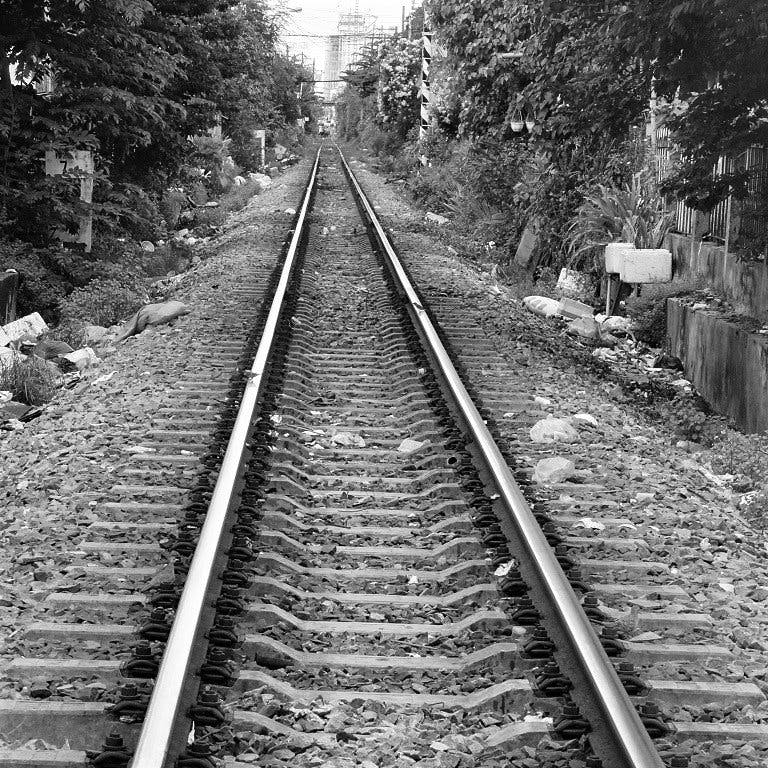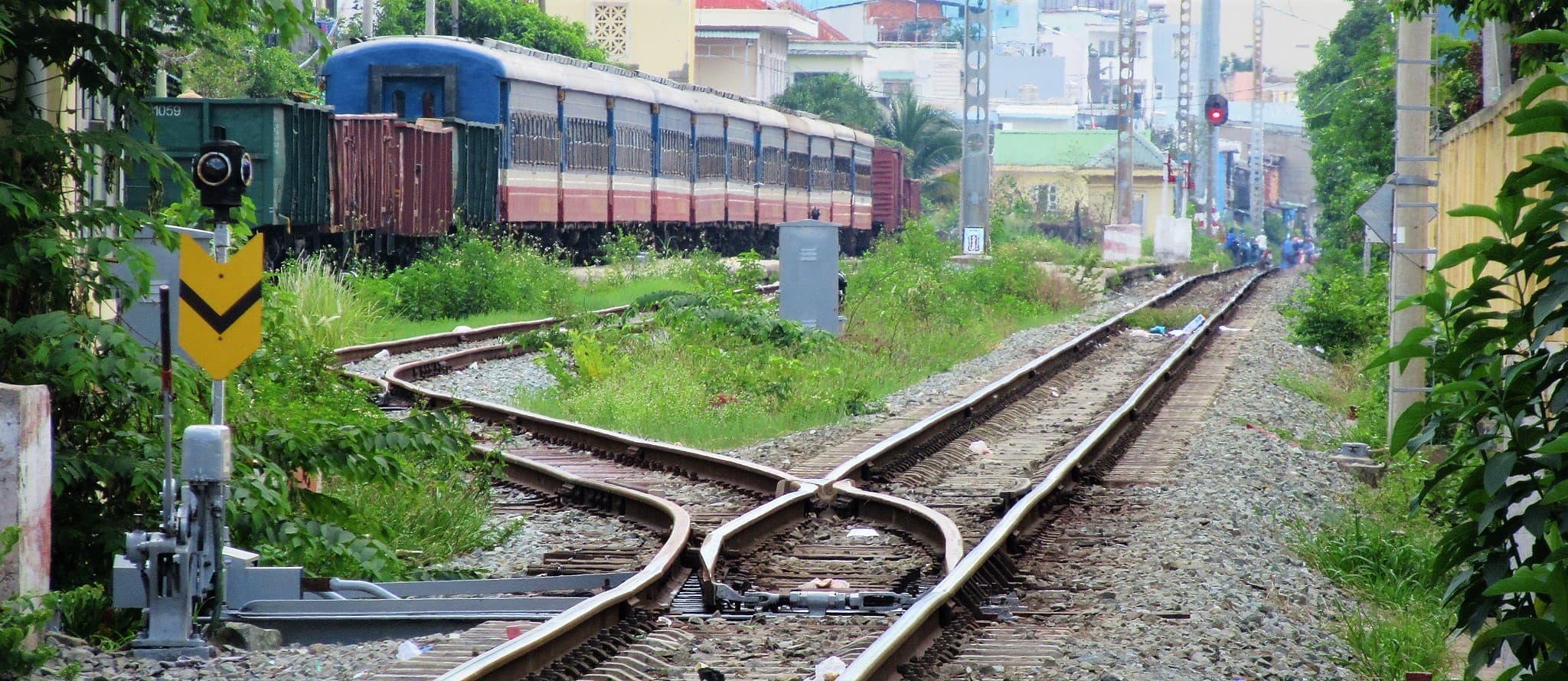First published June 2018 | Words and photos by Vietnam Coracle | 18 comments
This post was last updated 7 years ago. Please check the comments section for possible updates, or read more on my Updates & Accuracy page.
INTRODUCTION | GUIDE | MAP | RELATED POSTS
A few years ago, I lived close to the railway tracks in Saigon. Throughout the day (and night) I heard the blaring horn of the locomotives, succeeded by the rattling of the carriages as they passed through my neighbourhood on their way north. I loved the romance of being so close to the rails, and I was very sad when I had to move house (even though my housemates at the time would disagree: for them the train was an irritation). While living by the tracks, I began to explore the narrow paved lanes which run either side of the railway for several kilometres through the city. Lined with cramped housing, intriguing architecture, temples, shrines, pagodas, fruit trees, flowers, cafes, casual dining, trash, beer joints and other such urban miscellanea, it’s a fascinating area to explore, either on foot or on two wheels. Recently, I went back to the tracks where I used to live, in order to research and write this guide to drinking, dining, walking, riding, and sightseeing along Saigon’s railway tracks. Spend a day or two exploring the city’s railroad: it’s urban, ugly, pretty, gritty, cool, fun, and it’s very Saigon.

Life along Saigon’s railway line is vibrant, pretty, ugly, fun, & fascinating: it’s great for exploring
[Back Top]
GUIDE: EXPLORING SAIGON’S RAIL TRACKS
In this guide, I’ve mapped some of the interesting cafes and eateries by the railway, and included some intriguing places to stop and see near the train tracks. All but a couple of places in this guide are on the two narrow lanes that follow the course of the railway. It’s very pleasant to walk or ride this route, by motorbike or bicycle. However, the lanes by the tracks are not continuous: it’s sometimes necessary to duck out and rejoin them. But, although there are a few dead ends, in general, no matter how tight the alleyways become, there’s almost always a way through, so persevere. I’ve written this guide starting from the Saigon train terminus in District 3, then following both sides of the track as it veers north and northeast through the districts of Phu Nhuan, Go Vap, Binh Thanh, and across the Saigon River to Thu Duc District. Any time of day is good: early mornings and late evenings are quiet and cool; the middle of the day is hot and slow; and during the rush hours the lanes can get very busy. There’s an abundance of food and drink and potential for exploration along Saigon’s railway: this is just a brief guide. (For similar guides to other aspects of Saigon, take a look at the Related Posts.)
*WARNING: It should go without saying that you must be extremely careful when exploring any area near the railway tracks. Never assume the line is safe or clear: always stop, look, and listen. Accidents on Vietnam’s railways are alarmingly common.
MAP:
Exploring Saigon’s Rail Tracks
[Back Top]
Start at the largely disappointing (apart for the old steam locomotive at the entrance) Saigon train station. If you plan to walk, you can leave your motorbike at the station parking lot, opposite the main station building. However, the lanes leading either side of the tracks don’t begin until the first intersection after the station: at Tran Van Dang Street. Whether going by foot or on two wheels, grab a quick, satisfying snack of chuối chiên (banana fritters) at the place on the corner of the second set of tracks as it crosses Tran Van Dang Street. This is good fuel for the walk/ride. Alternatively, save your appetite for Quán Chay Thanh Tịnh, a friendly, clean, very Buddhist little vegetarian eatery, serving good veggie versions of classic Vietnamese noodle dishes, such as mì quảng and hủ tiếu.

A bowl of vegetarian mì quảng noodles at Quán Chay Thanh Thịnh by the railway line
For most of its length, there are railings between the tracks and the lanes. But when a train passes – which they do every 30 minutes or so – it feels mighty close to the homes, shops, cafes, restaurants, and people on the lanes. It’s a lot of fun when a train does pass, but beware: the volume of the horn is ear-shatteringly loud. What’s more, train drivers tend to be pretty trigger-happy, because the horn is their chief safety precaution when rattling along the cramped city tracks.

Trains pass very close to the lanes running parallel to the railway tracks in Saigon
Like rail lines all over the world, the Saigon tracks are used as a convenient rubbish dump by many of the residents and passersby. You’ll find old sofas, refrigerators, pottery, cutlery, and the usual household detritus distributed around the rails (despite government notices forbidding it). However, it’s also apparent that the rail tracks function as gardens for the homes lining it. Saigon residents have learned how to make the most of the rapidly disappearing space available to them. Thus, the tracks are planted with banana, jack fruit, breadfruit, starfruit, and papaya trees, and fragrant and colourful plants and flowers, such as Rangoon creepers, frangipanis, bougainvillea, and night-blooming jasmine. Locals use the space for morning exercises, to let their chickens wander, to hang their laundry, to walk their dogs, and to hang their caged birds in the shade of trees. There’s an undeniable charm to life along the Saigon tracks, at least for the casual observer, if not for the residents. There’s a distinctive character to it; an almost village-like quality. If you’ve travelled by train in India, for example, the Saigon railroad has none of the squalor, awful living conditions, and foul smell that it does on the subcontinent.

Life along the narrow lanes either side of the railway line is intriguing, village-like, & often green
After crossing the Nhieu Loc Channel, the lanes offer up a couple of interesting coffee shops and track-side eateries. Definitely stop in at the incredible Nhỏ Cafe, a pokey but hugely atmospheric ‘vestige cafe’, filled with old bric-a-brac like portable TVs, cassette players, sewing machines, paraffin lamps, dolls, records, bicycles, pottery, clocks, telephones and typewriters. Settle down to a strong Vietnamese coffee or a fruit juice and soak up the vestige vibes, with the trains passing a couple of metres away. For a snack, head to the corner with Le Van Sy Street, where Badar is a hole-in-the-wall selling crispy pizza-pancakes called bánh đa trộn. Or, for those who can abide it, check out the string of dog meat restaurants on the other side of the tracks. In the evening, it’s worth stopping by Creative Station to see if there’s an open event happening or simply for a drink.

Nhỏ Cafe sits next to the railway tracks: it’s a classic Vietnamese-style ‘vestige cafe’
Continuing beside the tracks after crossing over Le Van Sy Street, there are some cute murals decorating a section of wall on the left side. Then, take some time to soak up to the fantasia of ghoulish and garish iconography at Quang Minh Buddhist Temple, before sneaking off the tracks for a bite to eat at one of the many enticing street food stalls around Tran Huu Trang Market.

Quang Minh temple with its statues & reliefs sits right next to the rail tracks in Phu Nhuan District
Before hitting Nguyen Van Troi Street, the district communal spirit shrine (Đình Thần Phú Nhuận) is a nice, vaguely meditative spot dating from 1862 (pop in if the gates are open). Directly opposite, on the other side of the tracks, is a tight, dead-end alleyway whose close walls have been graffitied to the max. Duck down it and take a look.

‘Graffiti alley’ leads off the rail tracks down a narrow, dead-end lane
Crossing over Nguyen Van Troi Street, have a taste of the delicious bò lá lốt (also spelled lốp) at the diminutive eatery at number 80/23 Nguyen Van Troi. This dish consists of grilled beef rolled in aromatic betel leaves, wrapped in herbs and rice paper, and dipped in a pineapple-sweetened sauce. It’s a classic Vietnamese combination of textures and flavours; of cooked and fresh ingredients. It’ll fill you with pleasure. When you’re full, head a few metres down the tracks to Mien Dong Thao Cafe, with its waterfalls, fountains, and multi-leveled seating (yes, it’s a bit kitsch, but in a good way). If you’re feeling, err, ‘sporty’ check out the large billiard hall right by the tracks after crossing Nguyen Trong Tuyen Street. A few frames of pool and a couple of cold beers is a relaxing way to watch the trains go by.

Stop by to try the bò lá lốt (grilled beef wrapped in betel leaf) near the railway line: it’s delicious
The lanes on either side of the track between the intersections with Hoang Van Thu and Nguyen Kiem streets are particularly good for exploring. Head down a few of the narrow alleyways and get lost for a bit. There’s lots to like about Saigon’s alley life, including food, families, architecture, and the general warmth and comfort of life going on all around you. (If you need some more encouragement, check out my Alley Walks guide.)

Intriguing alleyways lead from the railway tracks deep into local neighbourhoods: go explore
Things get greener and more village-like after crossing the tracks at Nguyen Kiem Street. Showers of foliage fall over the houses and fences along the rail line. Perhaps this has something to do with the area’s myriad Buddhist shrines, temples, pagodas, monasteries, and universities. It’s surely no coincidence that one of the roads crossing the tracks here is Thich Quang Duc Street, named after the Buddhist monk, Thích Quảng Đức, whose flame-engulfed silhouette covered front pages across the globe in 1963, after his self-immolation (a protest against the anti-Buddhist, pro-Catholic leader of South Vietnam, Ngo Dinh Diem) was captured on film and camera. Also near the railway in this area is Vạn Hạnh Zen Buddhist Temple, which, as far as I understand, was founded by Thích Nhất Hạnh, the famed Vietnamese Zen Buddhist master who many will know from the 2017 documentary, Walk With Me, a thought-provoking and moving piece of film.

Van Hanh Zen Buddhist temple is just off the tracks, surrounded by lots of vegetarian restaurants
The presence of all these Buddhist places of worship means, of course, lots of vegetarian restaurants. Choose between the handful on Thich Quang Duc Street on the west side of the tracks. Or, if you prefer some meat in your diet, head to the soup house next to the tracks at 120/86 for a bowl of phở or bò kho (beef noodle soups). Continuing north along the railways towards Pham Van Dong Street, it’s possible to wind through the tight passageways to the unexpected Go Vap Station. It’s a odd place and there’s usually a few carriages waiting here on the sidings. Across the tracks, a tangle of fascinating alleyways spread east of the railway: great fun to explore.

The small & unexpected Go Vap train station, near the crossroads with Pham Van Dong Street
Between Pham Van Dong Street and the Binh Loi Bridge you’ll need to improvise a bit in order to stay as close to the tracks as possible. But it’s well worth the effort because the alleyways here are intriguing: sometimes very pleasant and full of life, other times quite grim. This is definitely the ‘wrong side of the tracks’, as it were: it’s noticeably less affluent on this section of railway. Housing is tight, sanitary conditions are poor, and many areas are in the process of being demolished to make way for new apartment blocks (of course). As in most large cities, there’s a stark contrast in Saigon between the haves and have-nots: the Vietnam Australia International School and the brand new Emart Mall (complete with Starbucks and suburbia-inspired white-painted villas encompassing it) rise above the open sewers and dilapidated housing on either side of the train tracks.

Lanterns & flags hang over the narrow alleyways along the train tracks, marking Buddha’s birthday
Google Maps actually works very well for negotiating the little lanes that twist along and then away from the railway line in this area. Some of the lanes are paved, but some are dirt tracks. Elephant grass, banana plants, herb gardens, and allotments grow up around the rail line. Set beneath a flourish of lush tropical foliage, Vuon Xoai Restaurant offers an atmospheric Vietnamese dining experience: tuck into fresh chicken dishes, including crunchy chicken salad and grilled chicken with lemongrass. As you get closer to the Saigon River, the level of construction increases. Most of this is connected to the new Binh Loi rail bridge project. The new bridge is due to replace the old one (constructed at the turn of the 20th century) by 2019. You used to be able to ride over the old bridge right next to the trains, but that’s no longer possible. Instead, head up to Pham Van Dong Street and take the Binh Loi road bridge across the Saigon River to Thu Duc District.

The Binh Loi rail bridge, constructed over a century ago, is soon to be replaced by a new one
Pick up the rail tracks again on the other side of the river. It’s possible to follow the tracks on both sides all the way to the Go Dua Channel. Kha Van Can Street is a large new road on the south side, but the road on the north side is smaller and much more interesting. Again, use Google Maps to negotiate the first tricky bit (including a dirt track along the rail sidings opposite the small Binh Trieu Station). But after a while the road is easy to follow and passes along a lively strip of shops, food stalls, street-side markets, and restaurants. Several Buddhist temples, shrines and schools dot this route, including Uu Dam Temple and Thien Quang Shrine.

The narrow alleyways following the tracks almost always come out the other side if you keep going
In the evening, dine at the goat restaurants along the train track or the hidden Ven Song seafood restaurant, with brick-and-thatch gazebos on the banks of the Go Dua Channel. After dinner, try the Vietnamese sweet treat of chè at Chè Thiên Xanh, which has a nice seating area right next to the rail line. Finally, top the whole trip off with a gin and tonic at the superb Schiller River Club bar on the Saigon River, watching the sun set over the waterway and the city skyline in the distance.

End of the line: finish with a Gin & Tonic overlooking the Saigon River at the fantastic Schiller River Club
[Back Top]



thanks for a really interesting article , the website presentation is 10/10
Thanks, Simon.
Tom
Loving this website – thank you! Have done a couple of the motorbike trips and honestly couldn’t recommend it anymore!
Thank you, Natalie!
Tom
Just came across great in-depth on Saigon rail lines looking forward to taking some street photography here
Thanks, Robert. I hope you get some good shots.
Tom
This is such a great blog—easily among the best I’ve ever read. I can’t wait to walk along the tracks and explore this area next month when I’m in Saigon.
Thanks for providing such a great resource.
Jason
Hi Jason,
Thanks, I appreciate that. I hope you enjoy exploring Saigon’s tracks as much as I did.
Tom
And, if you’re ever in Tokyo, I will take you out for a serious drinking and eating extravaganza.
Thanks again, man.
Jason
Thank you, sounds wonderful!
We walked along part of this track today and experienced a train passing through – very cool walk, we thoroughly enjoyed it. Thanks Tom 🙂
Thanks, Claire. Glad to hear you enjoyed it. Careful of those trains – they pass so close to the sidewalks.
I had a lot of fun exploring those tracks, too.
Tom
Great story. I love exploring and Saigon has so many hidden treasures to explore. This is on my list to explore next trip.
You website is my favourite. Even if I dont go out on the adventures, I love reading the stories.
Thanks, Linda.
Glad to hear you enjoy seeking out Saigon’s many ‘hidden’ places – it’s a great city for that.
I hope you enjoy exploring the tracks sometime soon,
Tom
Another wonderful travel adventure. It’s on my short list for my next trip to Saigon.
Thanks, Tom!
Thanks, John.
Great to hear that – I hope you get time to explore the tracks on your next visit to Saigon.
Tom
Hi Tom, once again you made a fantastic description and guide to explore an unusual perspective of Saigon. I don’t know if I’ll ever have the time to go and make the experience (and photos) in person but, knowing enough of Vietnam, reading your post of today has been (almost) like strolling around with you! You had an excellent idea with this guide, may be a little too tough for a tourist, but definitely intriguing for someone living in HCMC… Ciao!
Thanks, Giorgio.
Yes, it would be perfect for some urban photography. Perhaps next time we meet we can get a coffee at Nho Cafe.
I hope you get time to have a wander along the tracks some day,
Tom